Swing Trading
Swing Trading Strategies – The Holy Grail of Emini Futures Trading?
Emini Traders, Stock Traders, and Bond Traders alike, all seem to share a common fantasy of becoming a successful Swing Trader. True swing trading success, as elusive as Bigfoot himself, appears on the surface to solve a myriad of problems experienced by all traders, no matter what strategy they use. Day traders are often stopped out in noisy markets, the long term buy and hold trader suffers from delayed gratification issues, but the swing trader’s strategy promises to solve it all. Does it?
What is it about swing trading that makes it so difficult to master? When looking at historical emini charts, it would appear that swing trading should in fact be the easiest of all trading strategies to learn. Let’s define exactly what swing trading really is:
Swing trading is price speculation in any of a wide variety of financial instruments where the objective is to remain in the position for 2-5 days. Price in the financial markets, whether in a bull or bear scenario, has a tendency to swing back and forth like the pendulum on a clock. The intention of the trader who is “swing trading” is quite simply to time these moves as price swings from one extreme to the other. Whereas day trading positions are held for minutes or hours and longer term buy and hold strategies can often be held for months or years, this particular trading strategy falls in the middle. Positions can be opened by either buying or “going long” the particular market being traded, or by selling or “going short”.
Swing Trading Strategy
Now that we know what it is, let’s talk about the ingredients of our own swing trading strategy. Keep in mind the swing trader will need something closer to a day trading strategy than a longer term buy and hold strategy. If it’s an individual stock being traded, the swing trader has no interest in the fundamentals of the company. If it’s the indices, mutual funds, bonds etc… being traded, it’s the “swing in price” that’s important, not the instrument itself or even the news surrounding it.
When we developed the CFRN Swing Trader Product, we incorporated one of our proprietary indicators which we elegantly call – "The Elbow". 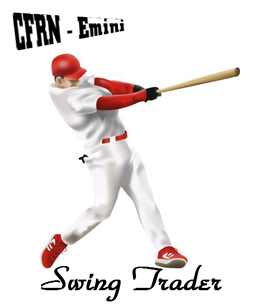
The trade entry is signaled when the Elbow is broken. This sounds more painful than it really is. All we’ve done, is taken our most basic indications and amplified them. The markets are fractal in nature. This is an undeniable market truth which you should grab ahold of it and never let go. Write this on the tablet of your heart and it will serve you well all the days of your trading life. It simply means that whatever happens on a 1 minute chart, will also appear on hourly charts, daily charts, etc…
The following emini charts are real life examples of this theory in action. In fact, these are the very trades which established the baseline parameters of the official CFRN Swing Trading Strategy.
Oct 14th - Buy above 1207 - market ran to 1230.75 / 23 points

Oct 21st - Buy above 1216 - market ran to 1254.50 / 38 points
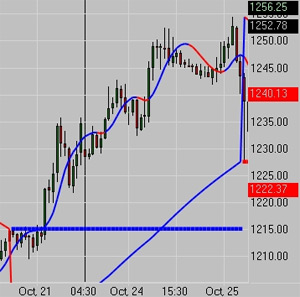
Oct 31st - Sell below 1264 - market dropped to 1208.50 / 55 points
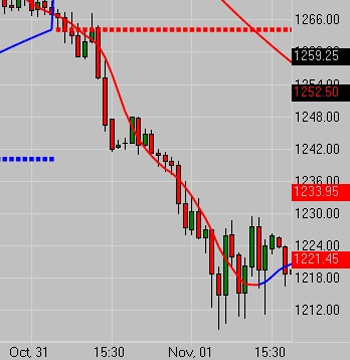
Nov 3rd - Buy above 1234 - market ran to 1259.75 / 25 Points
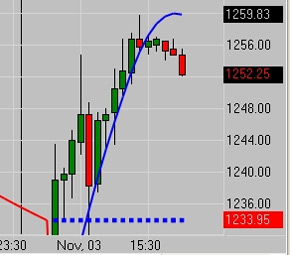
Nov 16th - Sell below 1238 - market dropped to 1147.50 / 91 points (note: this is the 3rd signal for 11/16/11)
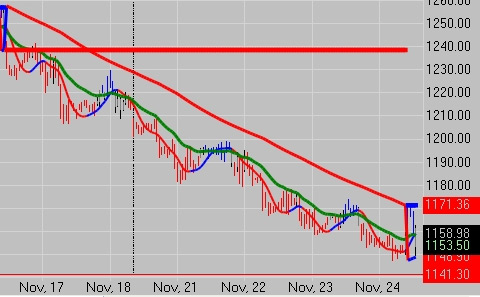
Nov 25th - Buy above 1172 - market ran to 1266.25 / 94 points
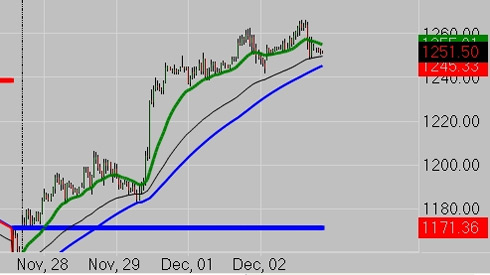
Dec 6th - Buy above 1262 - market ran to 1268 / 6 Points

Dec 7th - Sell below 1251 - market dropped to 1244 / 7 Points

Looks pretty simple right? So what makes successful Swing Trading so difficult? As an example, we’ll use a hypothetical S&P 500 emini trade where we anticipate the swing will be 15 points. Markets rarely ever travel in a straight line. This is especially true of the S&P 500. From your entry, there will be an initial swing of 3-5 points. We base this on a simple fact – “the average swing in the S&P 500 is 3-5 points”. If the market makes an initial swing from 1600 to 1605 and then retraces to 1602, you just watched 5 points of profit become 2. We also know that important prices and important areas are almost always tested. This means the retracement might come all the way back to 1600. At this point you are wondering what kind of a strategy is this? You went from 5 points of profit to zero, all based on a strategy which tells you price will ultimately swing 15 points.
As long as the trend ultimately continues, all is well. However, we must combine this discomfort with the fact that sometimes the trend does not continue and we learn quite painfully, the retracement was in fact a reversal. For most traders, this only has to happen once or twice and they quickly realize they do not have the intestinal fortitude to be a swing trader. Suddenly the idea of being an ordinary day trader or even a longer term investor seems very appealing.
Are there ways to conquer this? Is it possible to have the best of both worlds? Take our 1 Week Free Trial in our Live Emini Trading Room and we’ll answer that question and any others you have about emini futures trading. We’ll even let you download our emini trading platform and use our proprietary emini indicators (including the elbow) for 5 full days. There’s no obligation and no credit card required.








